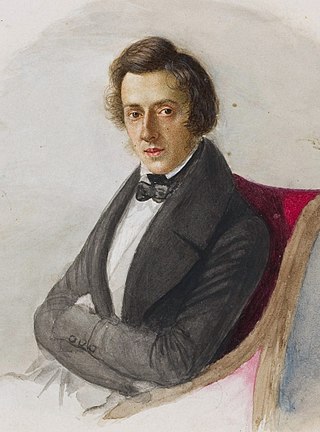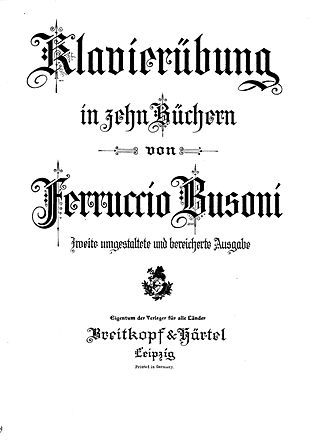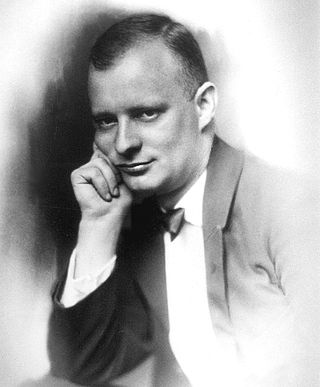
The Prelude in E-flat Major, Op. 23, No. 6 is a 1903 composition by Sergei Rachmaninoff. [1] [2] It is part of Rachmaninoff's Ten Preludes, Op. 23.

The Prelude in E-flat Major, Op. 23, No. 6 is a 1903 composition by Sergei Rachmaninoff. [1] [2] It is part of Rachmaninoff's Ten Preludes, Op. 23.
The E-flat major Prelude is written in a variation form. An extended sixteenth note accompaniment is offset by a three note reoccurring melodic germ in the right hand. The prelude is a serially reoccurring set of repetitions and variations.
Measures 1–9 establish the theme – a parallel period with a cadence in G minor – that continues throughout the piece. The theme is varied in measures 9–20 in G minor, F, E flat, A flat, F, and G. A repetition of the theme occurs at measure 21, and then is drastically simplified.
An exchange of ascending and descending chromatic sequences occurs at measures 31 and 32, offset contrapuntally by the changes of the primary theme.
Towards the end of the Prelude, an emphasis is placed on the sixteenth note accompaniment, which expands into two hands, rising upward in a chromatic pattern to the finish.
Alexis Weissenberg as well as Boris Berezovsky have recorded all the preludes written by Rachmaninoff. These works are available on various types of media. Many others recorded outstanding interpretations of the preludes, including Nikolai Lugansky and Van Cliburn.

Six moments musicaux, Op. 16, is a set of solo piano pieces composed by the Russian composer Sergei Rachmaninoff between October and December 1896. Each Moment musical reproduces a musical form characteristic of a previous musical era. The forms that appear in Rachmaninoff's incarnation are the nocturne, song without words, barcarolle, virtuoso étude, and theme and variations.

The Piano Sonata No. 2 in B♭ minor, Op. 35, is a piano sonata in four movements by Polish composer Frédéric Chopin. Chopin completed the work while living in George Sand's manor in Nohant, some 250 km (160 mi) south of Paris, a year before it was published in 1840. The first of the composer's three mature sonatas, the work is considered to be one of the greatest piano sonatas of the literature.

The Variations and Fugue on a Theme by Handel, Op. 24, is a work for solo piano written by Johannes Brahms in 1861. It consists of a set of twenty-five variations and a concluding fugue, all based on a theme from George Frideric Handel's Harpsichord Suite No. 1 in B♭ major, HWV 434. They are known as his Handel Variations.
Prelude in G minor, Op. 23, No. 5, is a piece of music by Sergei Rachmaninoff, completed in 1901. It was included in his Opus 23 set of ten preludes, despite having been written two years earlier than the other nine. Rachmaninoff himself premiered the piece in Moscow on February 10, 1903, along with Preludes No. 1 and 2 from Op. 23.
The Ballade No. 3 in A♭ major, Op. 47, is the third of Chopin's ballades for solo piano. It was composed in 1841 and published the same year.
Piano Sonata No. 2, Op. 36, is a piano sonata in B-flat minor composed by Sergei Rachmaninoff in 1913, who revised it in 1931, with the note, "The new version, revised and reduced by author."

The Piano Quartet No. 3 in C minor, Op. 60, completed by Johannes Brahms in 1875, is scored for piano, violin, viola and cello. It is sometimes called the Werther Quartet after Goethe's The Sorrows of Young Werther. The premiere took place in Vienna on November 18th 1875 to an anxious public. Richard Wagner and his wife Cosima were in attendance.
Excursions, Op. 20, is the first published solo piano piece by Samuel Barber. Barber himself explains:
These are ‘Excursions’ in small classical forms into regional American idioms. Their rhythmic characteristics, as well as their source in folk material and their scoring, reminiscent of local instruments are easily recognized.

The Klavierübung, by the Italian pianist-composer Ferruccio Busoni, is a compilation of piano exercises and practice pieces, comprising transcriptions of works by other composers and original compositions of his own.

The Prelude in B-Flat Major, Op. 23 No. 2 is a composition by Sergei Rachmaninoff completed and premiered in 1903.

The Prelude in F-sharp minor, Op. 23, No. 1 is a composition by Sergei Rachmaninoff completed and premiered in 1903. It is one of ten preludes composed by Rachmaninoff in 1901 and 1903.

The Prelude in D major, Op. 23 No. 4 is a 1903 composition by Sergei Rachmaninoff. It is part of Rachmaninoff's Ten Preludes, Op. 23.

The Prelude in C minor, Op. 23, No. 7 is a 1903 composition by Sergei Rachmaninoff. It is part of Rachmaninoff's Ten Preludes, Op. 23.

The Prelude in A-flat major, Op. 23, No. 8, is a 1903 composition by Sergei Rachmaninoff. It is part of Rachmaninoff's Ten Preludes, Op. 23.
The Prelude in E-Flat Minor, Op. 23 No. 9 is a 1903 composition by Sergei Rachmaninoff. It is part of Rachmaninoff's Ten Preludes, Op. 23, and is one of the most difficult of the set.

The Prelude in G-Flat Major, Op. 23 No. 10 is a 1903 composition by Sergei Rachmaninoff. It is part of Rachmaninoff's Ten Preludes, Op. 23.

The first Sonata for viola and piano, also known as Sonata in F, Op. 11, No. 4, by Paul Hindemith was composed in 1919. It is the fourth of five instrumental sonatas comprising his opus 11. This sonata and the following Op. 11 No. 5 for solo viola mark Hindemith's decision to abandon playing the violin in favor of its larger cousin.
Blues, Rags and Stomps, Op. 1, was composed by Robert Boury between 1970-1973. It consists two books, three movements each. Boury composed mostly during his graduate study at the University of Michigan in Ann Arbor. The first set was nicknamed “Varsity Rags”, which Eubie Blake admired and told the audience, “Now that’s ragtime”, after he heard Boury’s performance at the 1971 Toronto ragtime Festival. Book I and II consist of three movements each: I. A Tristan Two-Step, II. Alice Walking, and III. The Rocket’s Red Glare. Book II: I. Eubie’s Blues, II. Stroller in Air, III. I Left My Heart. Boury comments that “A Tristan Two-step” represents his breakaway from modern music and was a way to be accepted as a tonal composer.
Sergei Rachmaninoff wrote a number of preludes, all for solo piano.
The Études-Tableaux, Op. 33, is the first of two sets of piano études composed by Sergei Rachmaninoff. They were intended to be "picture pieces", essentially "musical evocations of external visual stimuli". But Rachmaninoff did not disclose what inspired each one, stating: "I do not believe in the artist that discloses too much of his images. Let [the listener] paint for themselves what it most suggests." However, he willingly shared sources for a few of these études with the Italian composer Ottorino Respighi when Respighi orchestrated them in 1930.